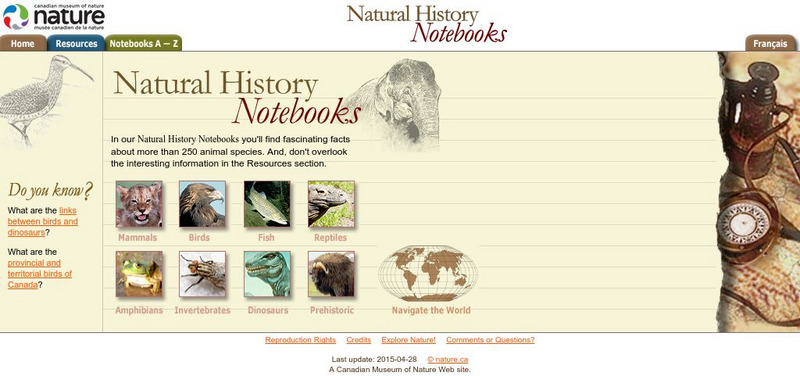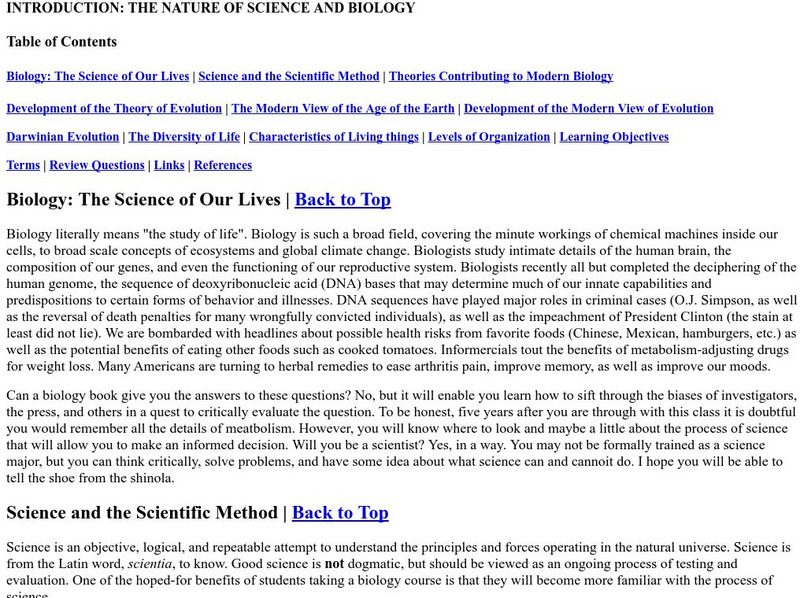Other
The Domains and Kingdoms of Life
This site is a description of the history behind the 5 Kingdom system suggested by Robert Whittaker. An extensive list of resources is included.
Canadian Museum of Nature
Canadian Museum of Nature: Natural History Notebooks
This site from the Canadian Museum of Nature, a natural history museum, provides short information blurbs and fun facts on over 240 different common animals categorized by type (mammals, fish, reptiles, invertebrates, amphibians,...
ClassFlow
Class Flow: Egg Citing Adventures
[Free Registration/Login Required] Chickens aren't the only ones who lay eggs. Through poetry and hands-on activities, students learn how birds, reptiles, fish, and amphibians are alike and different. Number activities and videos are...
Utah Education Network
Uen: Keys and Classifying
Sort and classify an assortment of objects relating to classifying Utah plants and animals.
BBC
Bbc: Earth: Tardigrades Return From the Dead
Tardigrades are ancient, fascinating creatures that can survive conditions that would kill most life forms, including extreme heat and absolute zero, extreme pressure and a vacuum, and deadly radiation. They can even survive being...
Other
Science4 Us: Animals
In online and offline activities, students broaden their understanding of animals by learning to identify and classify animals into six categories: mammals, birds, fish, amphibians, reptiles, and invertebrates.
American Museum of Natural History
American Museum of Natural History: O Logy: Meet the Zooarchae O Logist
An interview with Sandra Olsen, a zooarchaeologist studying the history of horses in Kazakhstan. Discover what zooarchaeologists work on in the interview.
Natural History Museum
Natural History Museum: Reptiles, Amphibians and Fishes
This online exhibit from the Natural History Museum branches out in many fields to cover the broad topics of reptiles, amphibians and fishes. Thirteen subtopics are provided including several videos and informative articles.
Other
Panhandle Area Educational Consortium: The Six Kingdoms of Life [Pdf]
Scientists look at the evolutionary history of organisms to divide them into kingdoms. For awhile, there has been 5 kingdoms, but many scientist are now using 6 kingdoms.
PBS
Pbs Nature Critter Guide: Mammals: Aardvarks
This PBS Critter Guide gives a brief description of the aardvarks life and habitat. This site would be useful for students who need help narrowing their Internet research information into a manageable amount.
Science Buddies
Science Buddies: How Biodiverse Is Your Backyard?
In this science activity, you will investigate the diversity (or biodiversity) of the animal life around your home and try to figure out which phylum most of the animals belong to.
Biology 4 kids
Biology4 Kids: Anemone and Coral the Cnidarians
An overview of the Phylum Cnidaria highlights the general characteristics of these strange creatures from the Animal Kingdom.
ClassFlow
Class Flow: South Carolina Animals
[Free Registration/Login Required] The flipchart explores habitats that support the different kinds of animals that live in the state. Students match pictures of animals to their habitats, unscramble letters to find the names of the...
ClassFlow
Class Flow: Vertebrates and Invertebrates
[Free Registration/Login Required] Using this lesson the students will review the 2 groups of animals - vertebrates and invertebrates. They will be actively involved in classifying animals. An Activote assessment is also included.
Wonderville Media
Wonderville: Ocean Habitats
Habitats are places where plants and animals live. There are many different habitats in the oceans of the world. Every plant and animal in the ocean prefers a particular habitat. Learn about Ocean Habitats in this well-constructed...
Wonderville Media
Wonderville: Cheetahs
The cheetah is the fastest land animal on the planet. It typically hunts during the day, chasing prey at speeds up to 70 miles per hour. Cheetahs live in eastern and southwestern Africa and parts of the Middle East. They reside in vast...
Estrella Mountain Community College
Online Biology Book: The Nature of Science and Biology
Use the scientific reasoning and critical thinking to take an in-depth look at the basics of biology.
Canadian Museum of Nature
Canadian Museum of Nature: American Pika
Get to know the American Pika.. colored photos, description, life cycle, map of habitat, food. Only the basic details of this little animal are given, making it perfect for younger researchers.
National Institute of Educational Technologies and Teacher Training (Spain)
Ministerio De Educacion: La Clasificacion De Los Organismo
This unit will describe the five kingdoms and their main characteristics. It includes 20 interactive activities.
Science Education Resource Center at Carleton College
Serc: Critter Catalog Creating a Field Guide to Minnesota Animals
Using communication skills, research skills, and thinking skills the students collaboratively create a field guide to Minnesota Animals.
E-learning for Kids
E Learning for Kids: Science: Antilles: How Can We Classify Animals?
Naomi teaches diving and meets all kinds of animals underwater. Join her and learn about grouping animals.
E-learning for Kids
E Learning for Kids: Science: Caribbean Sea: How Can We Classify Animals?
Welcome to Hideaway Island where five pirates need to find crews for their ships. Join in and learn about animals with backbones.
University of Guelph
Invertebrates
Site provides a comprehensive guide to anyone seeking information on invertebrates. Provides links to morphology, biodiversity, ecology and habitats.
Other popular searches
- Animal Kingdoms
- Kingdom Animal
- Animal and Plant Kingdom
- 5 Animal Kingdoms
- 7 Animal Kingdoms
- Five Animal Kingdoms
- Video on Animal Kingdoms
- Six Animal Kingdoms
- Plant and Animal Kingdoms
- Animal Kingdoms Plants
- Kingdom Animal Graeme Base
- Kingdom Animal Diversity

















